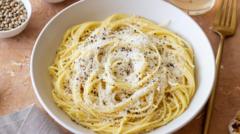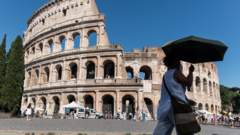**The publication's error reflects deeper cultural sensitivities surrounding culinary traditions in Italy, highlighting the importance of authenticity in Italian cuisine.**
**Recipe Dispute: Italian Fury Over Good Food's Cacio e Pepe Version**

**Recipe Dispute: Italian Fury Over Good Food's Cacio e Pepe Version**
**Italians express outrage after UK-based Good Food's misrepresentation of a traditional Roman pasta dish.**
Italians are taking a strong stance against the UK-based Good Food website following the publication of a recipe for the revered Roman dish, cacio e pepe, which sparked widespread criticism for its inaccuracies. The recipe, meant to be a quick meal option, listed four ingredients - spaghetti, black pepper, parmesan, and butter - and even suggested double cream as an alternative, a significant deviation from the authentic three-ingredient preparation of pasta, pepper, and pecorino cheese.
The outrage was not confined to casual diners; an association representing Italian restaurants took the matter to the British embassy in Rome, expressing disbelief that such a misrepresentation could come from a prominent British food platform. Claudio Pica, president of the Italian food association, articulated his astonishment, emphasizing the dish's deep roots in Roman cuisine that has transcended Italian borders.
Italian media coverage of the incident has amplified the critique, with public broadcaster RAI's journalist remarking on the irony of the mistake, given Italy's long-standing admiration for BBC standards. The fact that the Good Food brand, formerly owned by BBC Studios, had distanced itself from its BBC roots adds complexity to the backlash, as many Italians hold British culinary sources to a higher standard.
Restaurateur Giorgio Erami voiced his frustration, clarifying that what was published does not represent true cacio e pepe, but rather a different dish altogether. He likened it to 'pasta Alfredo', which bears little resemblance to the traditional recipe. While many chefs might explore variations of the classic dish, the central issue remains the notion that presenting an overly altered recipe as the original undermines the integrity of Italian culinary tradition.
Family-run establishments like that of Maurizio and Loredana, who have served tourists and locals in Rome for generations, have expressed a desire to preserve tradition. Maurizio sternly stated, "You cannot use the original Italian name for them," referring to the necessity of adhering to authentic recipes. Variations, such as adding lime to the dish, may be acceptable, but introducing ingredients like cream or butter fundamentally alters the essence of cacio e pepe - a point of contention for many Italians.
Others, like Eleonora from a central Rome cafe, recognize the emotional weight behind the anger. While she feels that such disputes may seem trivial, the foundational role of food in Italian identity cannot be overlooked. As the controversy continues to unfold, it serves as a reminder of the cultural significance embedded in culinary traditions and the sensitivities those traditions evoke. Immediate Media, the current owner of Good Food, has yet to respond to the outcry.




















